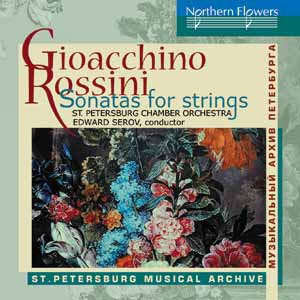CDs

NF/PMA 9901
Recorded: Capella Concert Hall, 1982
Sound engineer: Felix Gurdzhi
Digital mastering: Victor Dinov, 2000
Text: Era Barutcheva & Yuri Serov
Design: Oleg Fakhrutdinov, Anastasia Evmenova
|
Gioacchino Rossini |
||
|
Sonata No.1 in G major |
||
|
1. |
Moderato |
6.40 |
|
2. |
Andantino |
4.25 |
|
3. |
Allegro |
2.44 |
|
Sonata No.2 in A major |
||
|
4. |
Allegro |
7.34 |
|
5. |
Andantino — Allegro |
6.05 |
|
Sonata No.3 in C major |
||
|
6. |
Allegro |
5.15 |
|
7. |
Andante — Moderato |
7.28 |
|
Sonata No.4 in B flat major |
||
|
8. |
Allegro vivace |
7.24 |
|
9. |
Andante — Allegretto |
7.08 |
|
Sonata No.5 in E flat major |
||
|
10. |
Allegro vivace |
7.13 |
|
11. |
Andantino — Allegretto |
6.46 |
|
|
Îáůĺĺ âđĺě˙ |
69.33 |
|
|
|
|
|
Being totally fascinated by the magic operatic heritage of Rossini, we tend to forget the fact, that the great composer wrote not only for the musical theatre, but in other genres as well. However, the list of his choral, instrumental, chamber and vocal compositions is rather impressive. It includes masses, hymns, two symphonies, five string quartets, wind-instrument compositions, variations for different instruments, many vocal duets, arias and ariettas, twelve waltzes for a flute duet, and piano pieces for 2 and 4 hands. All of these works reveal their indisputable relationship with famous operatic compositions of the great maestro.
The above is true about Sonatas for Two Violins, Cello and Double-bass. The sonatas date from 1804, i.e. Rossini wrote them aged 12. Initially intended for a quartet they were later also performed by small string orchestra. It is the string-orchestra version which is represented in this recording.
Sonatas by Rossini remind of the early classical period in the development of this genre, when the term ‘sonata’ was a rather recent coinage, taken to mean an instrumental piece. Usually they consisted of 3 movements which had no sharp distinctions between each other. They rather presented various facets of the same conception.
There are some easily detectable typical features in the music of the sonatas, which became even more conspicuous and unique after Rossini had attained complete maturity. Among those features the following could be mentioned: cheerfulness of the general tone-color, richness of melody, light–heartedness of musical idiom and sparkling wit.
Each sonata is charming in its own way, each has its own zest. In the First Sonata the joyful and delicate final with its saltarello rhythm deserves distinction. Speaking about the Second Sonata one can hardly avoid the temptation to identify several pages of the introductory Allegro with the widely known overture to “Il Barbiere di Siviglia”. The charming cantilena performed by a duet of violins and a cello is also delightful. In the Third Sonata the combination of wonderful melody and mocking "hoots" reveals Rossini's good-natured irony. In the Forth Sonata the composer used similar musical phrases at the end of each movement, thus spanning a kind of an arch between them. The Fifth Sonata is extremely spirited and probably the most representative of Rossini’:s style. The first movement is playful and elegant, rather humorous are the staccato, ‘tiptoe’ episodes in andantino with the final being brilliant and bravura.
Although each sonata has its own distinctive features, they all have very much in common. It is interesting that these sonatas like many other instrumental compositions by Rossini have something, which is close to his operatic music. No doubt that the beauty of melodious tunes, humorous passages and brilliant technique are rooted in the operatic music.
The performance of sonatas demands high skill of ensemble playing, artistic culture and virtuosity. The St.Petersburg Chamber Orchestra directed by Edward Serov has coped with the difficult task brilliantly. This orchestra which has its own repertoire preferences and its own artistic style, is one of the most popular and competent ensembles of St.Petersburg. Together with Edward Serov, artistic director and chief conductor of the orchestra, the musicians have retrieved from the musical ‘storehouse’ samples of various epochs, little known in Russia, seldom or never performed here. A number of the compositions by Rameau and Couperin, Haydn and Vivaldi were kind of premiered by the orchestra. Conducted by Edward Serov it has performed several cycles: “Early Symphonies by Mozart”, “Early Symphonies by Schubert”, “J. S. Bach and his Sons”.
The orchestra players are excellent musicians. Understanding of the principles of chamber performance, perfect feeling of the style are vividly demonstrated by the recordings of the Rossini's sonatas.
|